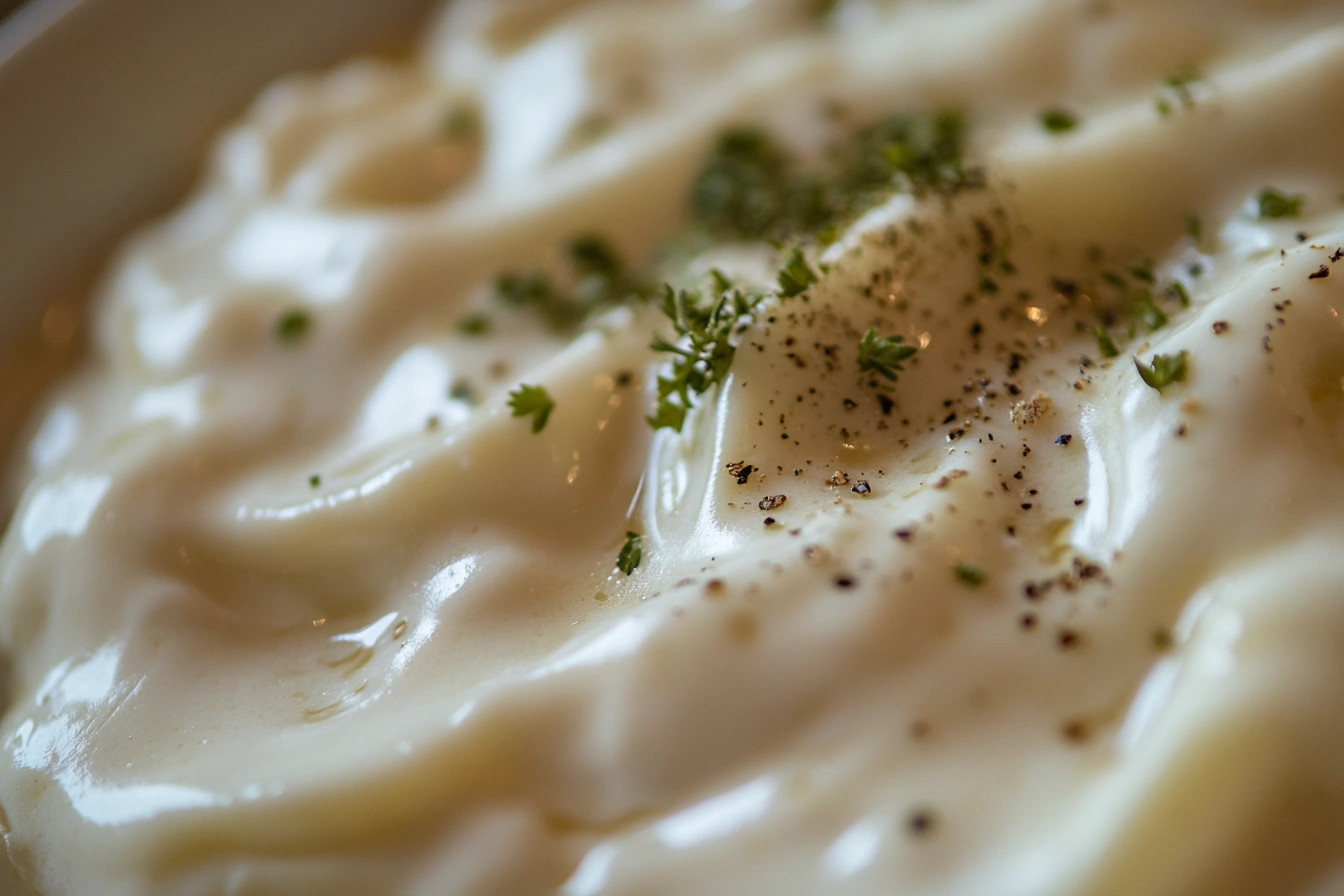Understanding White Sauce and Alfredo Sauce
1. Introduction
White sauce and Alfredo sauce are two popular creamy sauces that are often confused due to their similar appearance and texture. However, they are fundamentally different in ingredients, flavor, and purpose. While both are used in pasta dishes and sometimes in lasagna, they have unique origins and serve different culinary functions.
The main difference lies in their base ingredients:
- White sauce (Béchamel) is a French sauce made with butter, flour, and milk, forming a neutral base for many dishes.
- Alfredo sauce, on the other hand, is an Italian sauce made with butter, heavy cream, and Parmesan cheese, offering a much richer and cheesier taste.
This article will break down the key characteristics of each sauce, their common uses, and their nutritional differences. By the end, you’ll understand whether Alfredo can replace white sauce in lasagna or if they should be kept separate.
Table of Contents
2. What is White Sauce? (Béchamel)
Definition:
White sauce, also known as Béchamel sauce, is a classic French “mother sauce” made by cooking butter and flour together (a roux) and slowly adding milk until a smooth, creamy texture is achieved. It is one of the foundational sauces in French and Italian cuisine, forming the base for many other sauces like Mornay (cheese sauce) and Velouté.
Common Uses:
Béchamel is incredibly versatile and used in:
- Lasagna: Traditional white lasagna layers include béchamel instead of ricotta.
- Pasta: Used as a base for creamy pasta sauces.
- Gratins: Enhances baked dishes like potato gratin.
- Soups: Adds creaminess to bisques and chowders.
- Croquettes & Casseroles: Acts as a binding ingredient.
Flavor Profile:
- White sauce has a mild, creamy taste that enhances other ingredients.
- It’s often seasoned with salt, white pepper, and nutmeg, which gives it a slightly warm, nutty note.
- Unlike Alfredo, béchamel does not contain cheese (unless modified into a cheese sauce like Mornay).
Nutritional Information:
Compared to Alfredo, béchamel is lower in fat and calories because it uses milk instead of heavy cream. A light béchamel can even be made using low-fat milk or plant-based milk alternatives.
Béchamel’s lighter texture and neutral taste make it ideal for binding ingredients together in layered dishes like lasagna. It provides moisture without overpowering other flavors, making it the preferred choice for lasagna sauces.
3. What is Alfredo Sauce?
Definition:
Alfredo sauce is a rich, creamy Italian sauce traditionally made from butter, heavy cream, and Parmesan cheese. It originates from Rome, created by Alfredo di Lelio in the early 1900s as a simple pasta sauce. Over time, the modern American version added heavy cream and garlic for extra richness.
Common Uses:
Alfredo sauce is a staple in Italian-American cuisine, commonly used in:
- Pasta: Fettuccine Alfredo is the most famous dish using this sauce.
- Chicken dishes: Chicken Alfredo pairs grilled chicken with creamy sauce.
- Seafood dishes: Works well with shrimp, scallops, and salmon.
- Pizza & Flatbreads: Used as a creamy pizza base instead of tomato sauce.
Flavor Profile:
- Alfredo sauce is thicker, richer, and cheesier than béchamel.
- The Parmesan cheese provides a sharp, salty, umami taste.
- It has a buttery, creamy texture that coats pasta beautifully.
Nutritional Information:
Alfredo sauce is higher in fat and calories compared to white sauce due to its heavy cream and cheese content. A typical Alfredo sauce serving has:
- More saturated fat from cream and butter.
- Higher calorie content, making it a more indulgent option.
- Less versatility because its bold flavor can overpower delicate ingredients.
Because of its rich, thick consistency, Alfredo sauce doesn’t work as well as a layering agent in lasagna. It’s better suited for dishes where it coats pasta or proteins, rather than acting as a base like béchamel.

Key Differences & Usage in Lasagna
4. White Sauce vs. Alfredo: Key Differences
While both white sauce (béchamel) and Alfredo sauce are creamy, they are distinct in terms of ingredients, consistency, flavor, and usage. Below is a breakdown of their key differences:
| Feature | White Sauce (Béchamel) | Alfredo Sauce |
|---|---|---|
| Base Ingredients | Butter, flour, milk | Butter, cream, Parmesan |
| Consistency | Thick but smooth | Rich and velvety |
| Flavor | Mild, slightly nutty | Buttery, cheesy |
| Usage | Lasagna, gratins, soups | Pasta, meat dishes |
Why Alfredo Isn’t Traditionally Used in Lasagna
Alfredo sauce, with its rich, heavy consistency, is designed to coat pasta rather than bind layers in a dish like lasagna. The high-fat content can make lasagna feel overly greasy and cause the layers to slide apart, reducing structural integrity.
Additionally, traditional lasagna recipes require a sauce that absorbs into the pasta and holds the dish together. Alfredo sauce does not contain flour or starch, so it remains liquid rather than thickening during baking. This can make the lasagna watery and difficult to slice neatly.
Why White Sauce (Béchamel) is Better for Lasagna
- Acts as a Binder – Béchamel is thickened with flour, allowing it to hold the layers of lasagna together.
- Absorbs into the Pasta – The milk-based sauce is lighter and integrates well with the pasta sheets.
- Balances Other Flavors – Its mild taste complements rather than overpowers the other ingredients like ricotta, meat, and vegetables.
While Alfredo sauce is delicious, it does not serve the same functional role in lasagna as béchamel.
5. Can You Use Alfredo Instead of White Sauce in Lasagna?
Yes, Alfredo can be used instead of white sauce in lasagna, but some adjustments are needed.
When Alfredo Can Be Substituted
- If you want a richer, cheesier flavor in your lasagna.
- When making a Chicken Alfredo Lasagna instead of traditional lasagna.
- If you prefer a more indulgent, creamy texture.
Texture and Taste Differences
Replacing béchamel with Alfredo results in a heavier, richer lasagna. However, because Alfredo sauce lacks flour for thickening, it remains runnier when baked. This can cause:
- Watery lasagna if too much Alfredo is used.
- Slippery layers since Alfredo does not provide structural support.
- Overpowering cheesiness, as Parmesan has a strong umami taste.
Adjustments Needed for Alfredo Lasagna
To make Alfredo work better as a lasagna sauce:
- Thicken Alfredo – Add 1–2 teaspoons of cornstarch mixed with cold water to the sauce and heat until slightly thickened.
- Reduce the Amount Used – Use less Alfredo sauce to prevent the dish from becoming greasy.
- Mix with Ricotta – Blend Alfredo with ricotta cheese for a better consistency.
While Alfredo lasagna is delicious, béchamel remains the best choice for a traditional, well-structured lasagna.
6. Which Sauce is Healthier?
When comparing white sauce (béchamel) and Alfredo sauce, béchamel is generally the healthier choice due to its lower fat content and more adaptable ingredients.
Calories & Fat Comparison
| Sauce | Calories (per 1/2 cup) | Fat (grams) | Saturated Fat (grams) |
|---|---|---|---|
| White Sauce (Béchamel) | 100–150 | 5–7g | 3g |
| Alfredo Sauce | 300–400 | 25–30g | 15–20g |
- Alfredo sauce is significantly higher in fat and calories due to its heavy cream and butter content.
- Béchamel sauce uses milk, which is naturally lower in fat and can be made with low-fat or plant-based alternatives.
Nutritional Benefits of White Sauce
- Can be made with low-fat milk for a lighter version.
- Provides a neutral base, allowing for the addition of herbs, garlic, or cheese without overpowering the dish.
- Contains less saturated fat, making it heart-healthier than Alfredo.
Best Choice for a Balanced Diet
- If you want a lighter lasagna with better nutritional balance, béchamel is the better choice.
- If you prefer a richer, indulgent taste, Alfredo is acceptable in moderation.
For a health-conscious alternative, using a low-fat béchamel sauce allows you to enjoy lasagna without excessive calories or heaviness.

Part 3: FAQs and Conclusion
7. Frequently Asked Questions
Is Alfredo sauce just a type of white sauce?
No, Alfredo sauce is not the same as white sauce (béchamel). While both are creamy, Alfredo is made with butter, heavy cream, and Parmesan cheese, whereas béchamel is made with butter, flour, and milk. Béchamel is a base sauce used in many recipes, while Alfredo is a cheese-based pasta sauce.
Why is béchamel sauce used in lasagna instead of Alfredo?
Béchamel sauce is thicker and more structured because of its flour-based roux, which helps hold the lasagna layers together. Alfredo sauce, on the other hand, remains runny when baked and can make lasagna too rich and greasy.
Can I mix Alfredo and white sauce in lasagna?
Yes, you can mix both for a richer, cheesier lasagna, but it’s important to balance the flavors. Mixing Alfredo with béchamel can create a silkier texture while still maintaining structure. A half-and-half ratio works well to prevent overpowering the dish.
Which sauce is better for a low-fat diet?
Béchamel sauce is the healthier choice, especially when made with low-fat milk. Alfredo sauce is higher in fat and calories due to its heavy cream and cheese content, making it more indulgent.
Can I use store-bought Alfredo or béchamel for lasagna?
Yes! While homemade sauces offer the best flavor and texture, high-quality store-bought options can work. If using store-bought Alfredo, consider thickening it slightly with cornstarch or ricotta cheese to improve consistency.
8. Conclusion
In summary, while both white sauce (béchamel) and Alfredo sauce are creamy and delicious, they have different functions in cooking. Béchamel is the traditional choice for lasagna, as it provides structure, binds ingredients together, and balances flavors. Alfredo, with its rich, cheesy profile, is best for pasta dishes but can be used in lasagna with some modifications.
When choosing between the two, consider flavor, texture, and nutritional value. If you’re looking for a lighter, more balanced lasagna, béchamel is the best option. If you prefer a richer, more indulgent dish, Alfredo can work with some adjustments.
Now that you know the differences, you can decide which sauce suits your taste and dietary needs best! Whether you go with a classic white sauce lasagna or a creamy Alfredo variation, both options are sure to be delicious.

